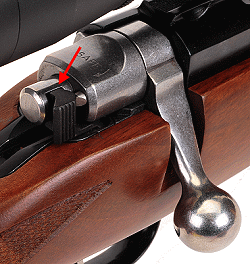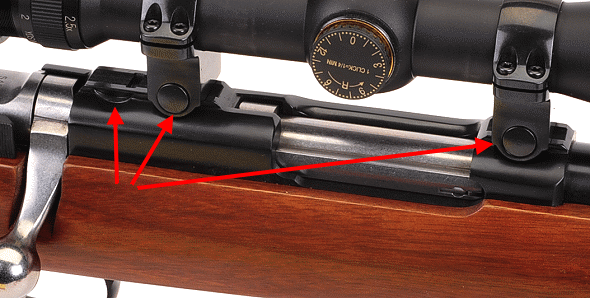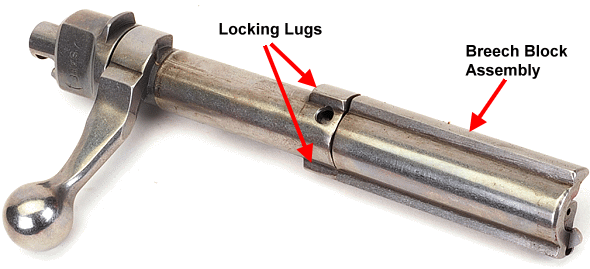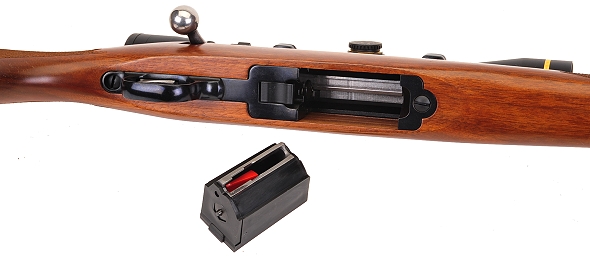
Shooting a rifle like this, working up some handloads is pretty much taking a few days off. The rifle, with scope, is compact and very light, recoil is near non existent. Report in mild, accuracy is good and the round is ideal for small game and varmint hunting.
Handloading the .22 Hornet is easy, inexpensive and flexible. And, no, the K Hornet is not needed as a step up in brass durability, the 0.6 grains picked up are worth about 27 feet per second in the best case and there is no such thing as adding meaningful kinetic energy to a cartridge this small. A combination like this? You take the rifle out of its box, mount a moderate magnification scope, pick up a box of ammo, and go shooting.
Ruger offers two types of 22 caliber Hornets; the first, a lightweight general purpose sporter and the second a varmint rifle with a longer and heavier profile barrel. The sporter is the subject rifle. The varmint rifle version can be seen on the Ruger site.
| Ruger’s 22 Hornet Rifles | ||
| Manufactured | Newport, NH | Newport, NH |
| Model | 7201 | 7204 |
| Magazine Capacity | 6 | 6 |
| Hardware | Blued Alloy Steel | Stainless Steel |
| Stock | American Walnut | Green Mountain |
| Overall Length “ | 39.25 | 43.25 |
| Length of Pull “ | 13.50 | 13.50 |
| Barrel length “ | 20 | 24 |
| Twist Rate “ | 1:14 | 1:14 |
| Weight – Lbs | 6.5 | 7.50 |
| Trigger Pull – Lbs | 4 ¼ | – |
| MSRP | $899 | $969 |
| Nominal Dimensions | ||
A well made, traditional rifle
The Ruger Model 77/22 22 Hornet, while compact, is built like a larger size sporter and full featured. As an example the rifle has a three position safety. A nice feature for an experienced firearm owner and a nice device for teaching firearm safety.

The Ruger cocks when the bolt handle is raised. In that condition, moving the safety all the way aft locks the safety into the cocking piece, blocking its forward motion and the bolt is locked in the closed breech position. Moving the safety to the middle position, load – unload, withdraw the safety from the cocking piece and allows the bolt to be cycled with the rifle still in a safe condition. Moving the safety all the way forward, safety off, permits firing the rifle.
The Model 77/22 utilizes Ruger’s proprietary scope mount system. There are three attaching points on the receiver that allow rings to be spaced to accommodate short or long tube scopes. The attaching points are notched for both horizontal and longitudinal hold. Rings supplied with the rifle are 1″ and medium height. Unused, Ruger will exchange them for 30mm rings or rings of a different height.

While the mount system is proprietary, there are numerous companies producing compatible rings and bases that covert the Ruger to Weaver bases or a Picatinny type rail.
The Model 77/22 has a stout breech locking system. The breech block rides as a set of rails that are keyed to the rifle’s receiver. It keeps the bolt face square to the rifle’s bore centerline and it makes for smooth feeding from the rotary magazine.

The dual locking lugs provide more than adequate lockup within recesses cut into the receiver, just aft of the ejection port. The firing pin cocks on open. The entire assembly is stainless steel.
The rotary magazine can be technically described as nifty. By pushing cartridges into a magazine and letting them wind around an internal rotor, more rounds fit into a smaller space and allow the magazine to be flush with the bottom of the rifle so that it doesn’t get into the way.

Not as obvious perhaps is the flat bottom breech block. By undercutting the block and moving the magazine up closer to the bolt’s centerline, a full breech face is preserved. However, contact between bolt face moved closer to the bolt centerline and cartridge centerline when stripping a round from the magazine. The result is a smoother bolt stroke and less required effort.

The 22 Hornet
 There is a 218 Bee, a 219 Donaldson Wasp and the 22 Hornet. Probably good it was named when it was because, after that, little wildcats went all Bobcat, Cougar, Badger, and even a Wolverine. The 22 Hornet actually began life in 1885 as the .22 Winchester Center Fire, a successful black powder cartridge that was designed for single shot rifles and persevered until approximately 1936. During the 1920s, a group at Springfield Arsenal tinkered with the cartridge, converted it to smokeless powder and chambered it in rifles like the 1903 Springfield and Martini single shot rifles. By 1930, the 22 Hornet was in commercial production and widely accepted within the industry, both in the U.S. and abroad.
There is a 218 Bee, a 219 Donaldson Wasp and the 22 Hornet. Probably good it was named when it was because, after that, little wildcats went all Bobcat, Cougar, Badger, and even a Wolverine. The 22 Hornet actually began life in 1885 as the .22 Winchester Center Fire, a successful black powder cartridge that was designed for single shot rifles and persevered until approximately 1936. During the 1920s, a group at Springfield Arsenal tinkered with the cartridge, converted it to smokeless powder and chambered it in rifles like the 1903 Springfield and Martini single shot rifles. By 1930, the 22 Hornet was in commercial production and widely accepted within the industry, both in the U.S. and abroad.
There was little physical change made to the 22 WCF. The 22 Hornet was made shorter, with slightly less capacity and operating at approximately 4,000 PSI lower pressure. The differences in other nominal dimensions are so slight that they probably overlap within tolerances. Abroad, the cartridge is referred to as the 5,6x35R Vierling and, yes, the comma separation was intentional. Now I feel like Vincent Vega discussing with Jules Winnfield why a Quarter Pounder with cheese is called a Royale with cheese in France. Yes, I possess a great deal of arcane firearms knowledge but, more to the issue of knowledge, I own a copy of Donnelly’s “The Handloader’s Manual of Cartridge Conversion”.
The 22 Hornet has distinctive, long sloping shoulders, a long neck and a heavy rim for extraction. It is also a very mild cartridge with an approximately 42,000 psi operating pressure. I’ve heard the 22 Hornet has short case life, flows brass and is finicky to reload. If that is true, I’ve never encountered those issue, but then I’ve only been loading this round for 30 years, give or take a few. There is about as much need for the K-Hornet with its 0.6 grain greater capacity as there is for the .30-30 Ackley Improved; both make for great theories and tall tales, but neither can really justify their existence.
Optimal bullets… too few to mention
Based upon a 1.720″ spec overall cartridge length and relatively lazy 1:14″ rifling twist , bullets for the .22 Hornet should be kept to 40 grain or under, lead core, and flat based. Boat tail bullets, and heavier weight bullets with a more sharply tapered ogive end up with parallel shank surfaces down inside the case neck. Can they be used? Sure, but they get ugly quickly and begin to look like the 50 grain BlitzKing on the far right.

Fortunately the Ruger Model 77/22 accommodates a COL as long as 1.795″ and offers a good deal of latitude when working up handloads. No leade bumping and no hanging on too short magazine length. For the purpose of live fire check out on the Model 77/22, four 0.224″ bullets were selected, the proper diameter for the current cartridge and rifle.
| Manufacturer | Type | Bullet Weight Grains |
COL Inches |
Powder Type |
Powder Charge |
Chrono FPS |
100 Yard 3 Shot Group “ |
| Sierra Varminter | HP | 40 | 1.795 | Lil’ Gun | 12.0 | 3093 | 0.9 |
| Sierra Varminter | HP | 40 | 1.795 | H110 | 12.1 | 3032 | 0.9 |
| Sierra Varminter | HP | 40 | 1.795 | 2400 | 10.0 | 2810 | 1.1 |
| Remington | HP | 45 | 1.720 | Lil’ Gun | 11.4 | 2967 | 0.7 |
| Remington | HP | 45 | 1.720 | H110 | 11.6 | 2837 | 1.0 |
| Remington | HP | 45 | 1.720 | 2400 | 9.5 | 2620 | 1.0 |
| Berger FB | HP | 50 | 1.790 | Lil’ Gun | 10.4 | 2731 | 0.7 |
| Berger FB | HP | 50 | 1.790 | H110 | 10.6 | 2620 | 1.1 |
| Berger FB | HP | 50 | 1.790 | 2400 | 8.7 | 2441 | 1.0 |
| Sierra BlizKing | Poly | 50 | 1.790 | Lil’ Gun | 10.0 | 2607 | 1.1 |
| Sierra BlizKing | Poly | 50 | 1.790 | H110 | 10.1 | 2556 | 1.2 |
| Sierra BlizKing | Poly | 50 | 1.790 | 2400 | 8.4 | 2444 | 1.2 |
|
CCI Small Rifle Primers in all loads |
|||||||
The Sierra 50 grain BlitzKing is not an inaccurate bullet in other applications. it is not a best choice for the 22 Hornet. Nothing noted during live fire phase out of the ordinary, other than it takes a while to get used to cool empties being ejected.
Wrap up
My preference with a choice of two barrel lengths for the 22 Hornet is the 20″ barrel. The cartridge is moderate range and the case capacity is modest. There is not enough untapped potential to warrant the extra barrel length and firearm weight. If I wanted greater accuracy at longer distances, I would begin by stepping up to the 223 Remington or larger and then increase barrel length. For what the 22 Hornet was intended to accomplish, the short barrel Ruger Model 77/22 is ideal.

Email Notification